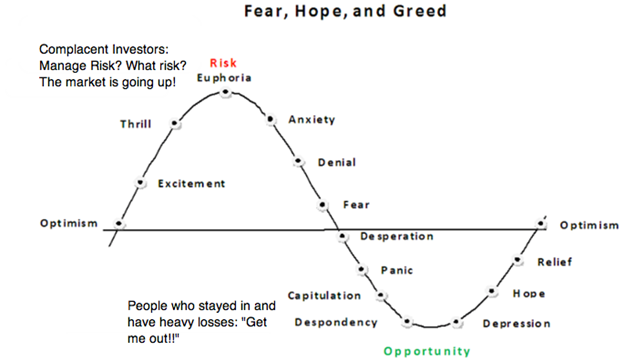While almost everyone is susceptible to the influence of emotional factors, it is important to raise these influences from the unconscious to the conscious. Educate yourself on the biases that investors are commonly prone to, and ask yourself whether your decisions are being influenced by them. By doing this, you give yourself the best chance of making rational investment decisions based on facts and logic rather than driven by your emotions.

Investing can be difficult at the best of times. With so much information, and such a wide array of products available, decisions can be hard. Adding to this confusion can be our emotional and behavioural biases. By better understanding our decision-making processes, we can act in a more rational manner which hopefully will lead to better investment outcomes.
Research suggests that the average investor generally underperforms broader market indices.
Dalbar, Inc., (‘Dalbar’) is a U.S. company that has been studying investor behaviour and analysing investor market returns for more than two decades. Their research consistently shows that the average investor earns below-average returns.
Dalbar found that for the 20 years ending December 31, 2019, the S&P 500 Index averaged 6.06% p.a. The average equity fund investor earned a market return of only 4.25% p.a.
Looking at investor returns since the onset of the Covid-19 pandemic, for the year 2020 the investor gap for equity investors was 1.11% (17.29% for the Average Equity Fund Investor and 18.40% for the S&P 500).
The average return gap between the average equity fund investor and the U.S. equity market widened considerably in the first half of 2021—doubling from 2020. Dalbar found that the average equity fund investor earned 13.14% in the first half of 2021, an underperformance of 211 basis points versus the S&P 500, which gained 15.25%.
Dalbar said one major reason for the lagging performance was that the average equity fund investor was a net withdrawer of assets in the first half of 2021, withdrawing 1.5% of assets in the first six months of the year. In doing so, investors reduced their exposure to the market recovery that occurred last year.
The role of emotions in investing
One way of better understanding how emotions affect investor behaviour is to look at the following chart – commonly known as the cycle of market emotions. It suggests that typically our emotions work against us.
As we enter bull markets, the optimism, thrill and excitement of rising values can lead us into thinking making gains is easy. It can also lead us to increase our level of risk at precisely the time we should be more cautious and take a more defensive approach. This is fueled by feelings of hope and greed.
Conversely, when markets are capitulating, we may be presented with strong buying opportunities. However, anxiety, fear and panic prevent us from investing. In some cases, these emotions of desperation are enough to drive us to exit the markets – at precisely the wrong point in time.
By understanding this cycle of market emotions, we may be able to better take advantage of investment opportunities while potentially mitigating risks.

Source: www.asymmetryobservations.com
Five behavioural biases to watch out for
As well as this simplified cycle of emotions, there are other biases that affect our decision-making processes in both strong and weak markets. Keep an eye out for some of the following that might be influencing your own investment behaviours:
- Cognitive Dissonance – When new information conflicts with pre-existing information and understandings, people typically feel uncomfortable. To counter this discomfort people will often perform obscure rationalisations to regain their level of comfort. As a result, we may often focus on the positives of the selection we have already made and ignore the downsides implied by the new information. From an investment perspective it means we may be overly focused on a stock or an ETF’s upside while ignoring the risks.
- Conservatism – this condition leads people to cling to their prior views at the expense of acknowledging new information. If a recent stock or market outlook is poor and is at odds with a previous positive outlook on the economy or stock, there is a tendency to disregard the latest set of information. It means we may under react to fundamental information. Don’t be afraid to make decisions based on recent, well-sourced information. Don’t get stuck on prior beliefs when it comes to investment decision making.
- Confirmation Bias – this refers to a tendency to accept information that highlights and confirms our own beliefs, while at the same time devaluing information that contradicts our beliefs. An example of this might be holding a belief that the Australian stock market performs better than other global markets. Positive forecasts for the Australian market may be accepted without question, while information supporting strong performance of international equities may be discounted. This may help us justify being invested in only Australian equities with little diversification. The lesson is to try and evaluate information from a neutral perspective, regardless of whether it challenges or supports our existing position and beliefs.
- Illusion of control bias – this describes the fallacy of individuals believing they can control and influence outcomes in situations that are impossible to control. This can lead to investors being impatient and trading in and out of the market under the assumption they can control the investment outcomes. It can also lead to overconfidence and taking larger than usual risks.
- Regret Bias – this can occur when people avoid making a decision on the basis that they believe whatever choice they make will be less than desirable. Under the influence of this bias, investors start to anticipate and fear the regret that may come with incurring a loss or forfeiting a gain. This can make investors timid and lead them to favouring investments they are familiar with. This may lead to missing out on new – but unfamiliar – investment opportunities such as emerging markets or new sectors, such as technology.
Summary

Written by
Benjamin Smith
Video and Content Executive
Ben brings a unique blend of financial acumen and creative storytelling to his role. With a solid background as a portfolio analyst, Ben possesses a deep understanding of the financial markets, investment strategies, and how ETFs work.
Read more from Benjamin.

